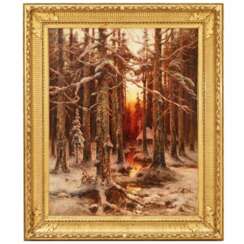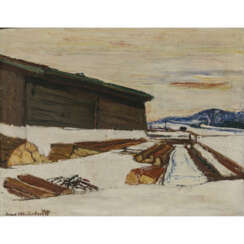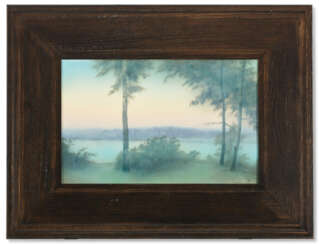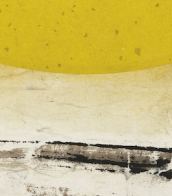landscape sunset

Daniel Graham was an American visual artist, writer, and curator in the writer-artist tradition. In addition to his visual works, he published a large array of critical and speculative writing that spanned the spectrum from heady art theory essays, reviews of rock music, Dwight D. Eisenhower's paintings, and Dean Martin's television show. His early magazine-based art predates, but is often associated with, conceptual art. His later work focused on cultural phenomena by incorporating photography, video, performance art, glass and mirror installation art structures, and closed-circuit television.


Andy Warhol, born as Andrew Warhola Jr., was an American visual artist, film director, and producer, who played a pivotal role in the development of the Pop Art movement. His art delved into the interplay between artistic expression, advertising, and celebrity culture, especially prevalent in the 1960s. Warhol was renowned for his diverse range of media, which included painting, silkscreening, photography, film, and sculpture.
Warhol's journey began in Pittsburgh, where he was born and raised, initially making a name for himself as a commercial illustrator. His New York studio, "The Factory," became a famous hub for intellectuals, celebrities, and various artistic minds. He was known for creating the notion of "Warhol superstars" and popularized the phrase "15 minutes of fame."
His contribution to the art world is significant, with notable works like "Campbell's Soup Cans" (1962) and "Marilyn Diptych" (1962), as well as his experimental films like "Empire" (1964) and "Chelsea Girls" (1966). These works not only define his career but also underscore the essence of the Pop Art movement.
Warhol's influence extended beyond his artwork. He managed and produced the experimental rock band The Velvet Underground, founded Interview magazine, and wrote several books, including "The Philosophy of Andy Warhol" and "Popism: The Warhol Sixties." Living openly as a gay man before the gay liberation movement, Warhol's personal life was as influential as his professional endeavors.
Tragically, Warhol's life was nearly cut short in 1968 when he was shot by radical feminist Valerie Solanas. He eventually passed away in 1987 due to cardiac arrhythmia following gallbladder surgery. His legacy continues, with The Andy Warhol Museum in Pittsburgh standing as the largest U.S. museum dedicated to a single artist.
Warhol's art remains highly collectible and valuable. His works, like the "Silver Car Crash (Double Disaster)" and "Shot Sage Blue Marilyn," have fetched staggering amounts at auctions, signifying his enduring impact on the art market.
For art collectors and experts, Andy Warhol's work represents a crucial intersection of pop culture and fine art, offering a unique perspective on consumerism and celebrity. His pieces are not just art; they are historical landmarks that capture a transformative era in both art and society.
To stay updated on new products, sales, and auction events related to Andy Warhol, sign up for our updates. This subscription will keep you informed about all things Warhol without overwhelming you with unnecessary information.



Johannes Holst was a German sailor and self-taught painter who specialised in seascapes.


Peter Paul Rubens was a distinguished Flemish Baroque painter, renowned for his dynamic, vibrant, and sensuous paintings. Born on June 28, 1577, in Siegen, Westphalia, Germany, Rubens' family moved back to Antwerp in the Spanish Netherlands (now Belgium) after his father's death. He was raised in his mother’s Roman Catholic faith and received a classical education. He began his artistic training in 1591 and later traveled to Italy, where he was profoundly influenced by Renaissance masters like Titian, Tintoretto, and Veronese. This experience significantly shaped his artistic style.
Rubens' art is celebrated for its emphasis on movement, color, and sensuality. He was particularly skilled in depicting religious and mythological scenes, portraits, and landscapes. Some of his notable works include "The Descent from the Cross" and "The Raising of the Cross," which are prime examples of Baroque religious art, showcasing his unique style that blended influences from Italian Renaissance and his own innovations.
Rubens was not just a painter but also a diplomat, serving at various European courts. He was knighted by both Philip IV of Spain and Charles I of England. His diplomatic missions often intertwined with his artistic endeavors, as seen during his travels to Spain and Italy. In addition to painting, he was involved in designing tapestries, prints, and book title-pages. He ran a large workshop in Antwerp, producing works that were popular with nobility and art collectors across Europe. His studio was in his home, the Rubenshuis, now a museum.
His influence extended to his students, notably Anthony van Dyck, and his collaborative works with other artists like Jan Brueghel the Elder. Rubens' work continued to be celebrated for its vitality and influence on the Baroque style, making him one of the most influential artists of his time.
For those interested in the work and life of Peter Paul Rubens, many of his works can be found in museums and galleries worldwide, including the National Gallery in London, which houses several of his paintings like "A View of Het Steen in the Early Morning" and "Minerva protects Pax from Mars ('Peace and War')".
To stay updated on new product sales, auction events, and more related to Peter Paul Rubens, sign up for our updates. We provide essential information tailored for collectors and experts in art and antiques, focusing on the magnificent work of Rubens and his enduring legacy in the world of art.


Sanford Robinson Gifford was an American landscape painter and a leading member of the second generation of Hudson River School artists. A highly-regarded practitioner of Luminism, his work was noted for its emphasis on light and soft atmospheric effects.


Pieter de Molijn, a distinguished Dutch Golden Age painter and engraver, was celebrated for his exceptional landscapes, genre pieces, and more. Born in London in 1595 to Flemish parents, he moved to the Netherlands, where he significantly contributed to Dutch art. Molijn was not just a painter; his talents extended to engraving, a testament to his versatility in the art world.
Pieter de Molijn's journey into art took him to Italy and then to Haarlem, where he joined the Guild of St. Luke in 1616, marking the start of a prolific career. His landscapes, known for their sweeping diagonals and tonal unity, helped pioneer a new style that influenced contemporaries and successors alike. Molijn's ability to capture the essence of the Dutch landscape made his works sought after, not just during his lifetime but also in today's art circles.
His works, like the captivating "Landscape with Figures," showcased at The Metropolitan Museum of Art, continue to fascinate art enthusiasts and collectors. Pieter de Molijn's artistry wasn't confined to landscapes alone; his genre pieces and marine scenes also garnered acclaim, reflecting his diverse skills and innovative approach.
For art collectors and experts keen on Dutch Golden Age paintings, Molijn's works represent a blend of technical mastery and artistic vision. Whether it's his detailed landscapes or compelling genre scenes, each piece invites viewers into the world he saw and experienced.
For those who appreciate the finesse of Dutch Golden Age art, staying updated on Pieter de Molijn's works is a must. Whether it's auctions, exhibitions, or private sales, sign up for updates and never miss out on the opportunity to explore or acquire Molijn's timeless masterpieces.


Hans De Jode was a Dutch marine painter of the Golden Age.
The theme of his work is related to the sea: he painted harbor scenes, bathers in bays, ships on a wharf, and Italian landscapes. The artist mainly lived and worked in Venice and Vienna.


John Linnell was an English engraver, and portrait and landscape painter. He was a naturalist and a rival to the artist John Constable. He had a taste for Northern European art of the Renaissance, particularly Albrecht Dürer. He also associated with the amateur artist Edward Thomas Daniell, and with William Blake, to whom he introduced the painter and writer Samuel Palmer and others of the Ancients.


Francesco Fidanza is an Italian landscape painter.
The main theme of the artist's work is the greatness and beauty of nature. Fidanza painted seascapes of the Mediterranean with storm clouds, views of snow-covered coastal cliffs, depicted the erupting Vesuvius; nature in his paintings lives and breathes.



Johannes Hermanus Koekkoek was a Dutch painter and draughtsman. Following his education, he worked as an art teacher, but soon decided to become a free-lance artist. In 1826, he moved to Durgerdam, near Amsterdam, where he would live and work until 1833. He initially combined seascapes and cityscapes but, in his later years, focused entirely on ocean scenes. Much of his inspiration came from the painters of the Dutch Golden Age. His style was essentially Realistic, but alos showed elements of the newer Romantic aesthetic. Rather than merely paint ships, he also learned as much as he could about the different types.


Claude Joseph Vernet was a French painter.
Vernet's work draws on natural themes, but in a way that is neither sentimental or emotive. The overall effect of his style is wholly decorative.


Alfred James Munnings was known as one of England's finest painters of horses, and as an outspoken critic of Modernism. Engaged by Lord Beaverbrook's Canadian War Memorials Fund, he earned several prestigious commissions after the Great War that made him wealthy. Between 1912 and 1914 he was a member of the Newlyn School of artists. His work was part of the art competitions at the 1928 Summer Olympics, the 1932 Summer Olympics, and the 1948 Summer Olympics.
Munnings was president of the Royal Academy of Arts from 1944 until his death.











































































